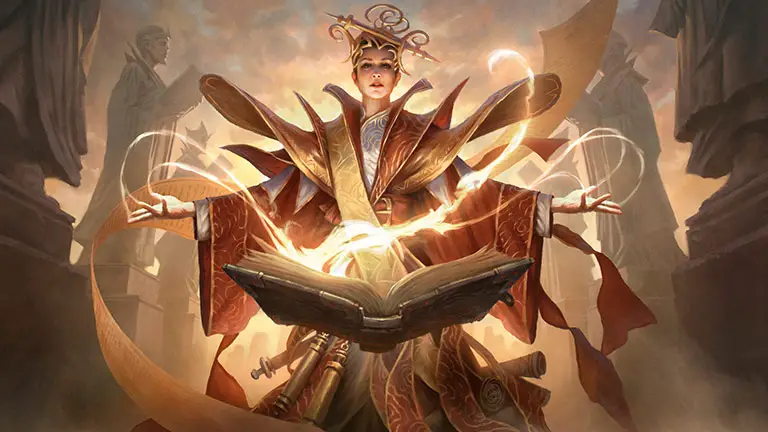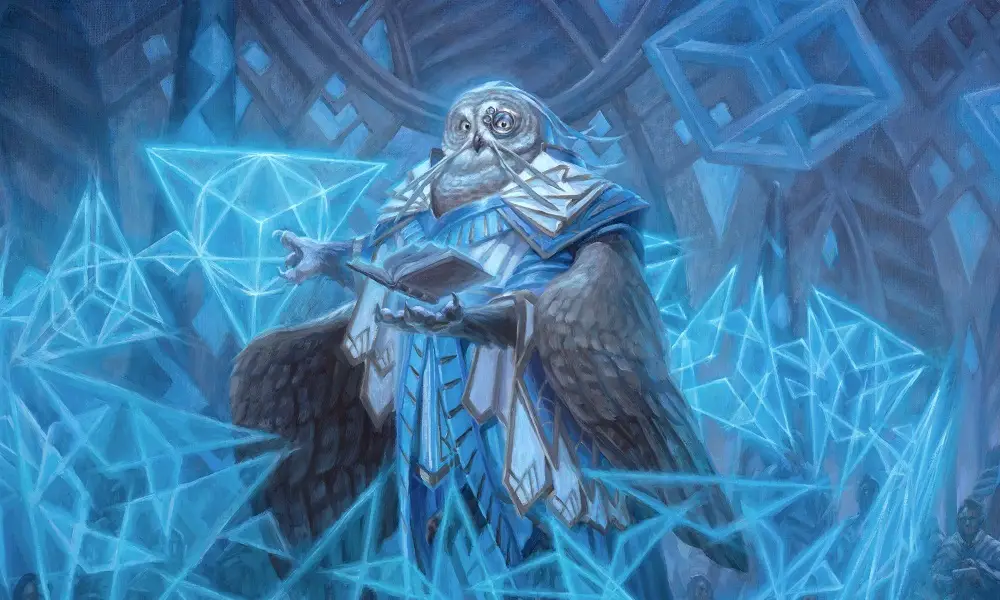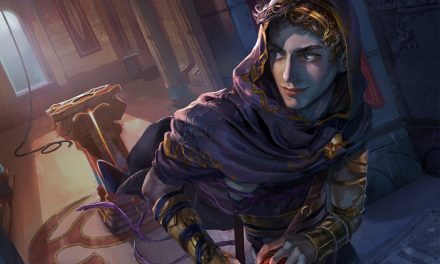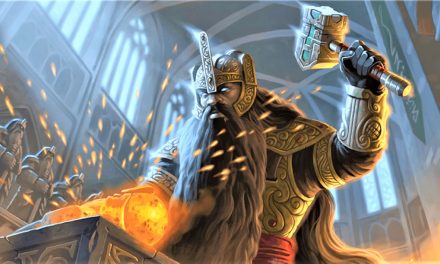Magic is an ancient and powerful force. Some of the most powerful spells are capable of untold creation and destruction that can rewrite reality in the multiverse as it’s known.
So of course some deities would take an interest in these Arcane secrets and practices!
Some of these deities seek to foster understanding, study, and the responsible use of magic. Others view magic as closely guarded secrets that are not meant to be shared. Meanwhile, others still view magic as the surest way to wield power over others.
Whatever view these deities take, there are Clerics who worship them and share those views on magic.
Do you wish to combine the powers of Divine and Arcane magic?
Then enjoy this full subclass guide to the Arcana Cleric in D&D 5e!
What is the Arcana Cleric in D&D 5e?
Arcana Clerics serve gods and goddesses of knowledge and magic. They have dedicated their lives in service to these deities and to the study of arcane power.
Some temples might be full of Arcana Clerics who work closely with academies and universities to teach responsible magic use.
Others might instead function as secretive vaults where the greatest magical minds in the land research and craft arcane spells or artifacts that are most certainly not intended for the average spellcaster.
Arcana Clerics tend to be bookish. They balance their inquisitive minds with piety and worship of the divine beings who oversee such arcane power.
There is a slight overlap in theme between Arcana Clerics and Knowledge Clerics. The two will commonly worship many of the same deities and can likely both be found in large libraries.
After all, most arcane power is commonly gained through research and intense studying!
However, Knowledge Clerics are very big on “knowledge for the sake of knowledge” while Arcana Clerics take a more focused approach to studying arcane power.
Deities commonly worshipped by Arcana Clerics include:
- Azuth, God of Mages and Wizards
- Mystra, Goddess of Magic and Mysteries
- Corellon Larethian, Elven God of Magic, Music, Art, Poetry, and Warfare
- Boccob, God of Magic, Arcane Knowledge, Balance, and Foresight
- Wee Jas, Goddess of Magic, Death, Vanity, and Law
- Vecna, a powerful Lich turned God of Evil Secrets
The Arcana Cleric appears in the Sword Coast Adventurer’s Guide.
Role in the Party
The Arcana Cleric brings elements of the Wizard class into its features and role in the party.
Fitting with the name, Arcana Clerics are geared towards heavily focusing on their role as spellcasters. They gain some of the Wizard’s arcane versatility but are not as squishy as Wizards tend to be.
There’s definitely an expectation that an Arcana Cleric will typically play towards the middle or rear of the party’s formation. However, we’ll talk about why that might not always be the case later in this guide when we’re going over this domain’s Arcane Initiate feature…
The Cleric spell list is already incredibly strong, so the Arcane spells you gain with this domain round it out with some extra utility.

Arcana Cleric Features 5e
As I mentioned, the Arcana Cleric is a kind of hybrid between the Cleric and Wizard classes.
Needless to say, you’re going to be getting features meant to expand what you’re capable of with your spellcasting.
Just like Wizards rely on a great deal of preparation to aid their party, you’ll also be a bit of a “Swiss army knife” yourself!
Arcana Domain Spells
Every Divine Domain (Cleric subclass) also comes with its own unique list of bonus spells. These are called Domain Spells.
You gain these Domain Spells when you hit the level on the table below. These spells are considered to always be prepared for you and they don’t count against the number of spells you can prepare each day.
Some Domain Spell lists might include spells that aren’t normally on the Cleric spell list. In these cases, the spell counts as a Cleric spell for you and uses your Wisdom modifier as the spellcasting ability.
So, let’s check out what you get for choosing the Arcana Domain!
| Cleric Level | Domain Spells |
| 1 | Detect Magic, Magic Missile |
| 3 | Magic Weapon, Nystul’s Magic Aura |
| 5 | Dispel Magic, Magic Circle |
| 7 | Arcane Eye, Leomund’s Secret Chest |
| 9 | Planar Binding, Teleportation Circle |
Borrowing its spells from the Wizard spell list, the Arcana Domain does a lot to offer you some extra utility options. Between these and the excellent Cleric spell list, you’ll have plenty of options at your disposal to be very helpful in all matters needing some magical expertise!
Thoughts on the Arcana Cleric Spell List
You will get a lot of use from Detect Magic on your journey. It is an incredibly useful spell to always have prepared and casting it as a ritual removes the need to spend spell slots.
Magic Missile is a quick and reliable staple from the Wizard spell list that you now have access to.
You probably won’t need the Magic Weapon spell too often unless you are going against creatures that resist nonmagical damage and your party has not found any magical weapons yet. But it’s good to have just in case (especially in the early levels.)
Just be mindful of the concentration requirement!
Nystul’s Magic Aura is very situational unless you’re trying to hide something from someone, set a magical trap, or get around another caster’s spell effect that’s based on creature types.
Dispel Magic is a powerful spell to deal with ongoing magical effects or arcane traps. You’ll be glad you always have it prepared! Magic Circle is less broadly useful but handy if you’re getting swarmed by one of the types of creatures it’s effective against.
Arcane Eye is great for safely scouting areas that would otherwise be too dangerous or inaccessible.
Leomund’s Secret Chest is handy for protecting your belongings and could be a good way to keep the story’s MacGuffin away from the BBEG or their henchmen. Just use it wisely lest you lose the chest entirely!
Teleportation Circle is always an excellent addition to any party with places to be. Just make sure that you’re taking advantage of any opportunity to add new location sigils to your list of places you can teleport to.
Planar Binding is situational but combines well with Magic Circle when you want to summon a creature and bind it to your service for some time.

Arcane Initiate (Level 1)
You’re a Wizard, Cleric!
Or should that instead be, “You’re a Wizard-Cleric!”
Either way, your magical know-how just got better!
You gain proficiency in the Arcana skill, and you gain two cantrips of your choice from the Wizard spell list. For you, these cantrips count as Cleric cantrips.
Proficiency in the Arcana skill means you’ll likely have no trouble identifying spells, spell-effects, or anything else that falls in the “magical stuff” category.
But what really shines here is gaining two cantrips from the large Wizard list.
Furthermore, these counting as Cleric cantrips for you means they’re likely to get some extra “oomph” from your Wisdom score when you get Potent Spellcasting at level 8!
Mind Sliver and Fire Bolt are solid options for some extra damaging cantrips that break from the radiant/necrotic offered by the standard Cleric cantrip options.
If you favor some front-line action, Booming Blade and Green Flame Blade will benefit greatly from your Potent Spellcasting at level 8.
When you get your bonus cantrip damage with your level 8 feature, these cantrips will deal that bonus damage. BB gets the bonus to the secondary damage while GFB gets it against the second target then both at level 5. Rules-boss Jeremy Crawford confirmed both on Twitter. (GFB here and BB here)
But don’t ignore the non-damage options from the Wizard spell list either!
Cantrips like Light, Message, and Minor Illusion can also be incredibly beneficial!
Channel Divinity: Arcane Abjuration (Level 2)
You gain a new way to use your Channel Divinity feature at level 2.
This works very similarly to the standard Turn Undead option from the base Cleric class features. However, it’s more geared towards ruining one target’s day as long as they’re of a valid creature type.
As an action, you present your holy symbol. One celestial, elemental, fey, or fiend of your choice that is within 30 feet of you must make a Wisdom saving throw (provided that the creature can see or hear you).
If the creature fails its saving throw, it is turned for one minute or until it takes any damage.
The turned creature must spend its turns trying to move as far away from you as it can and cannot willingly end its movement in a space within 30 feet of you. It also cannot take reactions.
For its action, it can only use the Dash action or try to escape from an effect that prevents it from moving. If there is nowhere to move, the creature can use the Dodge action.
After you reach level 5, when a creature fails its saving throw against this feature, the creature is banished for one minute (as in the banishment spell, no concentration required) if it isn’t on its plane of origin and its challenge rating is at or below a certain threshold, as shown on the Arcane Banishment table.
| Cleric Level | Banishes Creatures up to CR… |
| 5 | 1/2 |
| 8 | 1 |
| 11 | 2 |
| 14 | 3 |
| 17 | 4 |
Also Check Out: Using Turn and Destroy Undead in D&D 5e!
Using Arcane Abjuration
There’s no shortage of fiends, fey, and elementals to fight in D&D 5e. For Undead enemies, you’ve got Turn Undead from the base Cleric features.
This will also help you if you’re fighting celestials, but what could happen that sees you fighting those?! I’ll reserve judgment… for now…
The biggest thing here is that you’re only targeting one creature. You want to use this on the biggest threat in the encounter that you think will have more difficulty with a Wisdom save.
Later, you’ll be able to just remove threats from the combat entirely! If they come back, you’ll still have a much easier time dealing with them!
The Turn effect is incredibly useful, but the Banishment effect leaves a bit to be desired. Those are pretty low CRs versus your level that you really should have no problem just dealing with the old-fashioned way.
That said, Arcane Abjuration plays well into the idea of an Arcana Cleric who is prepared for a wide range of possible situations. It’s situational by nature, but still has wide enough applications that you’re virtually guaranteed to get some use out of it.

Spell Breaker (Level 6)
Some enemies are fond of using spells that can massively debuff your allies. Getting hit by a spell like Hold Person or Slow can be downright devastating!
Thankfully, you’re able to offer some extra pick-me-up when you’re healing your allies!
When you restore hit points to an ally with a spell of level one or higher, you can also end one spell of your choice on that creature.
The level of the spell you end must be equal to or lower than the level of the spell slot you use to cast the healing spell.
Healing Word is the Cleric’s best friend so you really should have it prepared. Being able to heal an ally (and end a debuff on them) as a bonus action is pure excellence.
With your knowledge of Arcana, you should also have a general idea of what level you need to cast it at to give your friend some healing and remove a pesky spell effect from them.
Note that you get to choose what effect ends. However, if they’re seriously unlucky and have multiple debuffs on them, you’ll need multiple heals to remove all of them with this feature.
Enemies that like to use these kinds of spells aren’t super common. Evil spellcasters (especially if they’re necromancers or enchanters), Hags, Liches, and a few more tend to favor debuffs.
Potent Spellcasting (Level 8)
It’s time to buff up those cantrips!
I mentioned earlier that this plays VERY well with your Arcane Initiate feature from level 1, so get ready for the cantrips you chose to get a nice power-up!
You add your Wisdom modifier to the damage you deal with any Cleric cantrip.
Arcana Clerics are strongly geared more toward spellcasting than melee combat. Getting to tack on some extra damage to your cantrips is very nice.
You’ve still got Cleric staples like Sacred Flame and Toll the Dead. But any damaging cantrips you chose from the Wizard spell list are counting as Cleric spells for you which means they’re getting this buff too!
You should have absolutely gotten your Wisdom score to 20 by this point. It’s easily your most important ability score as an Arcana Cleric.
If you picked up a feat, you should still at least have a Wisdom of 18.
Potent Spellcasting means you’re dealing an extra 4 or 5 damage (depending on your Wisdom score) with each successful hit of these cantrips. That will add up quickly!
Just be aware that this buff specifically only applies to Cleric cantrips. If you gain even more cantrips from multiclassing or a feat like Magic Initiate, those won’t benefit from this.
However, you should be pretty good on cantrips.
Arcane Mastery (Level 17)
I’d bet my hat that this is the reason you chose the Arcana Cleric.
If it’s not, then it absolutely will be!
Choose four spells from the Wizard of spell list, one each from levels 6, 7, 8, and 9.
Each of these is added to your list of domain spells. Like your other domain spells, they are always prepared and count as Cleric spells for you.
This is mind-numbingly great.
Considering how huge the Wizard spell list is, you’ve got some serious options here. Even beyond what you decide to take for levels 6, 7, and 8, getting Wish for your level 9 spell becomes the ultimate once-a-day catch-all.
The spells you choose are entirely up to you and what you believe will best fit your character and party. However, let me offer a few standout options for each spell level:
| Spell Level | Recommended |
| 6 | Contingency, Chain Lightning, Disintegrate, Mental Prison |
| 7 | Forcecage, Magnificent Mansion, Reverse Gravity, Simulacrum, Teleport |
| 8 | Dominate Monster, Feeblemind, Illusory Dragon, Maze |
| 9 | Wish, Wish, Wish, (maybe also Wish if you want?) |
But let’s be honest, you’re taking Wish, right? I mean… it’s only the most powerful spell in the game and can literally rewrite all of reality…
So, make sure you also check out my article that fully covers the Wish spell!
Arcane Mastery is an incredible capstone feature for the Arcana Cleric. Few capstone features in all of D&D 5e carry the amount of character-defining weight that this one does!
Especially because Wish is available through this, it’s entirely possible to build an entire character around attempting to obtain this capstone feature on their journey. Every word of research and every second spent studying has finally led them to this exact moment!

Connections
As with many Wizards and some of the more studious Clerics, the Arcana Cleric certainly lends itself towards more of a bookish background. They might work within a magical library, teach Arcane theory at a university, or have some other similar background.
An interesting aspect of the Arcana Cleric that you can work into your character is the balance between Divine and Arcane magic.
How does the mixture of arcane study/science combine with faith-based divine magic in their overall philosophy and experience?
Connecting an Arcana Cleric into a party or adventure can be done fairly easily.
As with any arcanist, they might have a difficult time passing on the opportunity to gain new knowledge or unlock some kind of secret. An adventure can provide an excellent opportunity for some good old-fashioned field research!
If you’re planning a longer campaign, you could even build your entire character’s story around getting the Wish spell! Some adventurers have certainly spent their lives risking life and limb for less!
Don’t be afraid to play the long game when it comes to connecting an Arcana Cleric and their motivations into the game. It will be well worth the wait!
Is the Arcana Cleric Good?
Arcana Clerics are best in the later levels of the game. That’s when you’ve got the best selection of spells and a capstone feature that lets you get access to some incredible spells like Wish.
If you’re starting at a low level, you’ll consistently feel like there’s more you could be doing. The base Cleric class is strong enough that you won’t be weak, but you don’t really get your “big moment” until the highest levels.
Though, that could possibly even make an interesting premise for a character.
If you’re playing an Arcana Cleric, you’re either starting at a higher level or absolutely playing the very long game.
Just make sure that your group has a Session Zero where it’s outlined whether the group expects to keep playing the campaign up to these higher levels.
The truth is that most campaigns don’t go up to level 17 and beyond. You’d hate to spend so much time working towards your character’s capstone only for the story to end before you get it!
If you’re playing a longer game and want to play a Divine spellcaster with some Arcane mixed in, the Arcana Cleric is a great option.
If you aren’t likely to play a longer campaign or would prefer an Arcane caster with some Divine spellcasting mixed in, you might also check out my guide to the Divine Soul Sorcerer.
Recommended: Ranking Every Cleric Subclass in D&D 5e!
Conclusion – Arcana Cleric in D&D 5e
I hope you’ve found this guide to the Arcana Cleric in D&D 5e helpful!
Because it’s tucked away in the Sword Coast Adventurer’s Guide, this subclass and the others that appear in it (like the Long Death Monk or the Oath of the Crown Paladin) tend to get forgotten.
What a shame!
I think it’s an interesting subclass that fits a particular playstyle. While it doesn’t fully blossom until the later levels, it’s very remarkable when it does!
Got questions or a fun character concept for an Arcana Cleric? Let’s chat in the comments!
Want all the latest player guides, DM tips, news, reviews, and more for D&D 5e? Sign up for the Tabletop Joab newsletter below!
You can also follow me on Facebook and Twitter.
If you found this article helpful and want to support the site, you can buy me a coffee here! (It’s not expected, but very appreciated!)









